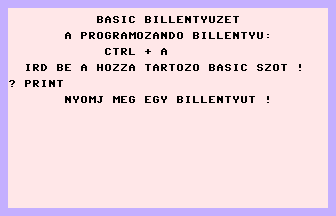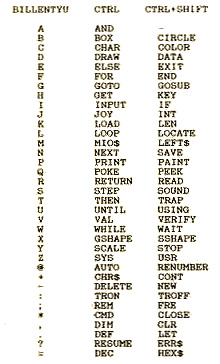|  Billentyűzetkódoló Billentyűzetkódoló | | Title: | Billentyűzetkódoló | | Category: | Utility/Programming | | Release Date: | 1986-03 | | Language: | Hungarian | | Size: | 16K | | Machine: | PAL & NTSC | | Code Type: | Basic + Machine code | | Distribution: | Type-in | | Notes: | Written by (private). Allows the user to edit and use a customized set of keys driven shortcuts to directly print the Basic's commands on screen. |
No votes yet.
|  |
|
| |
|  Description Description | Billentyűzetkódoló consists of two separate programs: Billentyűzetkódoló program and Billentyűkódolás szabadon.
Billentyűzetkódoló program activates a pre-edited set of keys combinations in order to directly print entire Basic commands on screen, by using most of the keys in combination with Ctrl and Shift+Ctrl. The combinations in use had been reported on the magazine as follows.
 Billentyűzetkódoló keyset
Billentyűkódolás szabadon actually is the same Billentyűzetkódoló program in which the keys table in the DATA lines have been zeroed, and the user is enabled to edit his own keyset. Pressing the chosen key, both without Shift (for the Ctrl+[key] combinations) and with Shift (for the Shift+Ctrl+[key] combinations), the program asks for the desired command and verifies if it matches an existent one. Press Esc to finish the editing, and the program will delete the additional program's part. At that point, RUN the remaining program, which is now basically the same as the original Billentyuzetkodolo program but with a new keyset's DATA values.
Very important note! Before running Billentyűkódolás szabadon, the REM lines from 1 to 6 must be deleted (DELETE1-6)!
The magazine's editors added those REM files as a standard tag for any of the lists they published. Incidentally, the keyset editor features a ML code which writes the two characters corresponding to the value to be assigned to a certain keys combination, by literally POKEing those values into the DATA lines. This means that the ML code only works if the DATA values are located in memory – thus, in the Basic lines – exactly in the place where the author had set them. Hence, the arbitrary adding of those REM lines change the required memory locations, so they must be deleted first.
|
| |
Copyright © Plus/4 World Team, 2001-2025. Support Plus/4 World on Patreon |